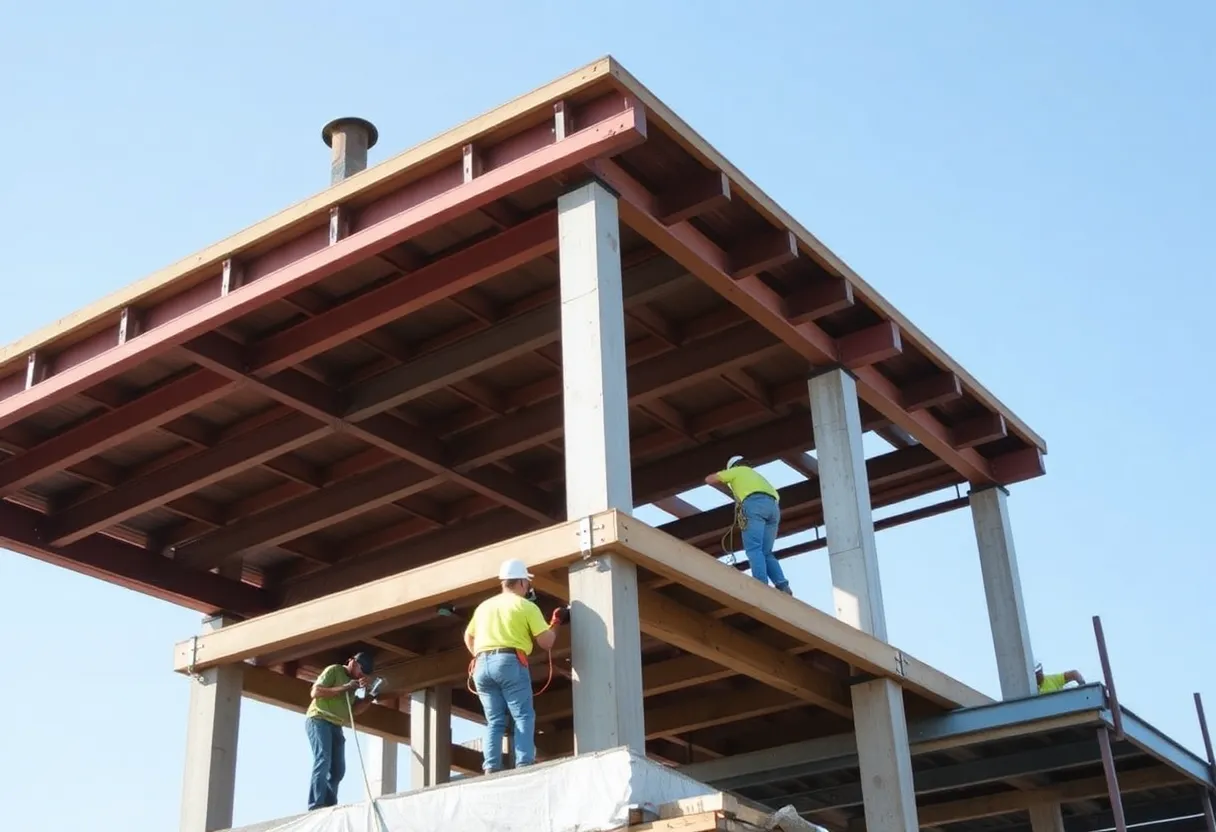Edmonton, north London, October 1, 2025
News Summary
The construction sector is under mounting pressure as Large Panel System (LPS) residential blocks trigger evacuations, buyouts and borough-level decommissioning after inspections found cracking, thermal movement and fire-safety risks. Councils face high remediation bills and in some cases opt to demolish or sell affected stock. Industry advisers and insurers are responding with new risk tools — including parametric cover, captives and pre-arranged capacity — while contractors seek contract models that better balance risk. Workforce shortages, rising costs and supply-chain strains compound the challenge, leaving residents, leaseholders and subcontractors facing disruption and financial stress.
Construction risk, building safety and insurance: industry pressure grows as safety evacuations and cost shocks mount
Summary
The construction sector is facing a complex mix of operational, financial and safety pressures that are driving urgent action across projects and housing stock. At the same time, high-rise residential blocks built using Large Panel System (LPS) concrete have prompted immediate evacuations, buyouts and borough-level decommissioning decisions after inspections found structural and fire-safety concerns. Risk advisers, contractors and project owners are responding with new insurance tools, contract reviews and alternative risk-transfer strategies while also managing rising costs, supply chain disruption and workforce shortfalls.
What officials and industry advisers report now
Tenants/leaseholders were told to leave Walbrook House in Edmonton, north London, because it was built with Large Panel System (LPS) concrete. LPS stands for Large Panel System and consists of prefabricated concrete panels. After a similar block partially collapsed in 1968 (Ronan Point), safety risks were repeatedly flagged about LPS buildings. Councils have also asked residents to move from other LPS blocks after inspections found cracking, thermal movement of panels and risks to fire compartmentation.
One council decided to act decisively on LPS stock and has taken steps to remove gas supplies from affected blocks and install alternative heating, alongside buyout offers for leaseholders. Enfield Council decided in April to decommission all LPS blocks in the borough and either demolish or sell them because remediation works were said to be more than £30 million. In other boroughs, blocks were previously earmarked for demolition after fire and structural surveys highlighted issues that were costly to fix.
Industry risk assessment and insurance market response
Major risk advisers note that current challenges shaping construction companies’ risk profiles include digitalization, climate risks, rising construction costs, and supply chain choke points. Firms are urged to understand emerging exposures and to design frameworks that balance retention, management and risk transfer. One adviser states it brings industry-specific expertise and global experience and offers consulting, brokerage and claims advocacy services that leverage data, technology and analytics to help clients better quantify and manage risk.
In insurance markets, several trends are highlighted: parametric insurance is pointed to as a flexible solution for hard-to-predict events such as extreme heat and earthquakes; buyer-friendly conditions began in late 2024 and continued into early 2025 in some markets; and alternative risk transfer solutions including captives and parametric layers are gaining attention to fill protection gaps in catastrophe-prone exposures.
Contracts, procurement and contractor concerns
Project owners frequently push risk to contractors using contract models such as EPC, design-build and public-private partnerships. These models can produce large losses and cause contractors to avoid them. Contractors are increasingly seeking structures that balance risk, including progressive design-build, alliance and integrated project delivery. A leading industry adviser recommends the contractual review process is crucial and that contractors should work with brokers that understand local coverage nuances; if contracts are not set up to cover delay, disruption, supply chain issues, labour shortage and design difficulty, insurance may not respond.
Workforce and supply-side pressures
Workforce shortages and an ageing labour pool remain urgent issues. Nearly 1 in 4 construction workers are older than 55, and some national labour surveys show declines in construction employment in early 2024. One industry estimate suggests the U.S. construction industry needs to attract half a million new workers in 2024 to balance supply and demand. With fewer and less skilled workers available, productivity suffers and job site safety is put at risk.
Examples of tools and capabilities being promoted to manage risk
- Risk analytics suites for quantitative insights and operational efficiency.
- Parametric insurance to cover grey-swan and extreme perils where traditional cover is limited.
- Pre-arranged capacity facilities across relevant lines for global placements.
- Claims teams and loss control services to help resolve major losses and optimize recovery liquidity.
Scale and claims capability
In one reported industry figure, In 2024, Marsh placed more than US$6 billion in construction insurance premiums. Another reported capability notes that Marsh states its team of over 1,000 construction professionals operate in more than 130 countries and that its claims team consists of more than 100 claims handlers, including former insurers and loss adjustors. Advisers encourage contractors and owners to align insurance programs to strategic objectives, optimize capital and protect business continuity.
Where this leaves residents and contractors
Tenants, leaseholders and subcontractors face immediate disruption and financial stress. Some leaseholders report being offered buyouts they consider insufficient to purchase similar homes locally. Subcontractors face cash-flow pressures and report elevated concern about defaults. Local authorities cite the high cost and disruption of refurbishment as reasons for choosing demolition or sale over remediation in some cases, while also offering compensation packages intended to reflect market value plus home loss and disturbance payments.
Outlook
The sector is moving toward greater use of data-driven risk assessment, alternative insurance arrangements and tighter contract management. At the same time, urgent safety decisions regarding specific building types continue to drive immediate relocations, decommissioning and demolition choices that affect residents, contractors and local housing supply.
Frequently asked questions
Q: Why were people told to leave Walbrook House?
A: Tenants/leaseholders were told to leave Walbrook House in Edmonton, north London, because it was built with Large Panel System (LPS) concrete.
Q: What does LPS mean?
A: LPS stands for Large Panel System and consists of prefabricated concrete panels.
Q: What historical event is linked to current LPS concerns?
A: After a similar block partially collapsed in 1968 (Ronan Point), safety risks were repeatedly flagged about LPS buildings.
Q: What action did Enfield Council take on LPS blocks?
A: Enfield Council decided in April to decommission all LPS blocks in the borough and either demolish or sell them because remediation works were said to be more than £30 million.
Q: How large was the reported insurance placement by one firm in 2024?
A: In 2024, Marsh placed more than US$6 billion in construction insurance premiums.
Q: How extensive is one advisory team’s global construction capability?
A: Marsh states its team of over 1,000 construction professionals operate in more than 130 countries.
{
“@context”: “https://schema.org”,
“@type”: “FAQPage”,
“mainEntity”: [
{
“@type”: “Question”,
“name”: “Why were people told to leave Walbrook House?”,
“acceptedAnswer”: {
“@type”: “Answer”,
“text”: “Tenants/leaseholders were told to leave Walbrook House in Edmonton, north London, because it was built with Large Panel System (LPS) concrete.”
}
},
{
“@type”: “Question”,
“name”: “What does LPS mean?”,
“acceptedAnswer”: {
“@type”: “Answer”,
“text”: “LPS stands for Large Panel System and consists of prefabricated concrete panels.”
}
},
{
“@type”: “Question”,
“name”: “What historical event is linked to current LPS concerns?”,
“acceptedAnswer”: {
“@type”: “Answer”,
“text”: “After a similar block partially collapsed in 1968 (Ronan Point), safety risks were repeatedly flagged about LPS buildings.”
}
},
{
“@type”: “Question”,
“name”: “What action did Enfield Council take on LPS blocks?”,
“acceptedAnswer”: {
“@type”: “Answer”,
“text”: “Enfield Council decided in April to decommission all LPS blocks in the borough and either demolish or sell them because remediation works were said to be more than £30 million.”
}
},
{
“@type”: “Question”,
“name”: “How large was the reported insurance placement by one firm in 2024?”,
“acceptedAnswer”: {
“@type”: “Answer”,
“text”: “In 2024, Marsh placed more than US$6 billion in construction insurance premiums.”
}
},
{
“@type”: “Question”,
“name”: “How extensive is one advisory team’s global construction capability?”,
“acceptedAnswer”: {
“@type”: “Answer”,
“text”: “Marsh states its team of over 1,000 construction professionals operate in more than 130 countries.”
}
}
]
}
Key features at a glance
| Topic | Key points |
|---|---|
| Immediate building safety | Evacuations and buyouts for blocks built with Large Panel System (LPS); councils decommissioning stock where remediation costs exceed tens of millions. |
| Structural risk drivers | Cracks, thermal movement of panels, breakdown of compartmentation, and added fire risk from degraded panels and stored lithium batteries. |
| Insurance market responses | Increased interest in parametric insurance, alternative risk transfer, pre-arranged capacity facilities and enhanced claims capability. |
| Contract and procurement risks | Shift away from fully risk-transferring models like EPC toward progressive design-build and alliance structures to better balance risk. |
| Workforce and cost pressures | Labour shortages, an ageing workforce, rising construction costs and supply chain choke points affecting productivity and safety. |
| Scale examples | In 2024, Marsh placed more than US$6 billion in construction insurance premiums; advisers report multi-country teams and dedicated claims handlers. |
Deeper Dive: News & Info About This Topic
Additional Resources
- Marsh: Construction
- Wikipedia: Construction management
- BBC: Walbrook House evacuation / LPS concerns
- Google Search: Walbrook House LPS evacuation
- Aon: How North American construction contractors can mitigate emerging risks
- Google Scholar: construction risk mitigation
- WTW: Renewable energy and construction risks
- Encyclopedia Britannica: renewable energy construction
- The Conversation: Britain’s net-zero construction workforce at risk of burn-out
- Google News: construction workforce burnout
Author: Construction FL News
The FLORIDA STAFF WRITER represents the experienced team at constructionflnews.com, your go-to source for actionable local news and information in Florida and beyond. Specializing in "news you can use," we cover essential topics like product reviews for personal and business needs, local business directories, politics, real estate trends, neighborhood insights, and state news affecting the area—with deep expertise drawn from years of dedicated reporting and strong community input, including local press releases and business updates. We deliver top reporting on high-value events such as the Florida Build Expo, major infrastructure projects, and advancements in construction technology showcases. Our coverage extends to key organizations like the Associated Builders and Contractors of Florida and the Florida Home Builders Association, plus leading businesses in construction and legal services that power the local economy such as CMiC Global and Shutts & Bowen LLP. As part of the broader network, including constructioncanews.com, constructionnynews.com, and constructiontxnews.com, we provide comprehensive, credible insights into the dynamic construction landscape across multiple states.





